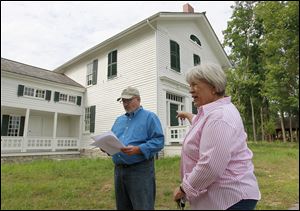
Historic Sylvania 'Lathrop house' finally ready to open
Newly restored building once hid slaves
7/29/2014
Toledo Metroparks spokesman Scott Carpenter and Sue McHugh talk about the Lathrop House, once a safe haven for slaves and part of the Underground Railroad. It will officially open Saturday.
To describe it as a long journey would be an understatement. After more than a decade Sue McHugh’s vision for the Lathrop House has finally become a reality.
The Lathrop House, once used as a safe haven for slaves on their road to freedom, will officially open for public tours after a dedication ceremony Saturday.
“It’ll be 13 years in October. But who’s counting?” said Ms. McHugh, president of the Friends of the Lathrop House, which raised funds for the home’s restoration and reconstruction.
Ms. McHugh, among others, dedicated her time to ensuring the home was preserved. It was part of the Underground Railroad and was used in the mid 1800s as a place of refuge for black men and women hiding from slave catchers.
Now a Sylvania landmark and testament to the region’s importance in securing independence for African-Americans, the grass-roots movement to save the home sparked a battle that divided the community and lasted for years.
“It was a bitter battle. Some people on both sides were very bitter. I think some people out there are still bitter about it,” said Keith Haddad, a former Sylvania Council president.
St. Joseph Parish bought the house on its original property in October, 2001 with plans to demolish Lathrop House and extend the school campus. After a lengthy and contentious dispute, the house was moved about 100 yards east to Harroun Park, which abuts the original site.
“Today, I’m fine with it. It was a solution. We got to save the house. I do wish we got to save it as it was,” Mr. Haddad said.
St. Joseph’s Msgr. Dennis Metzger could not be reached for comment.
As a result of the move the original basement was destroyed.
A dedication ceremony marking the opening of the basement and a museum will be held 1 p.m. Saturday at 5500 Main St. Deacon John Algee will give an invocation. He will be followed by speakers Sylvania Mayor Craig Stough, Lera Doneghy, vice president of the Metroparks of the Toledo Area board of commissioners, and Cathy Nelson, president of the Friends of Freedom Society in Columbus.
The second phase of a multiphase project, the basement reconstruction uses original stones from the home.
“By the time we got to it, the home had been remodeled several times,” Ms. McHugh said.
Because no original plans of the home existed, it was redesigned from oral history told by others and one resident who lived in the home as a child. The restoration cost about $370,000. About $290,000 of the cost was covered by an Ohio Department of Transportation grant and about $80,000 from the Friends of Lathrop.
During an archaeological dig, the original steps leading to the basement were uncovered. The steps built on the east side of the house allowed slaves to move from Harroun Barn on Harroun Road to Lathrop using a ravine to stay hidden.
Inside the basement a modern museum portrays a written and pictorial history. It begins with the international slave trade and ends in telling in how Sylvania and the region fit into the nation’s story.
The second room was designed as a re-creation of the basement as it would have been in the 1800s with stone walls, original wooden beams for the ceiling, and low-lit candles. There are two ovens implanted in the wall. One would have been used for cooking and the other would be a false oven with a tiny hidden door that led to a crawl space.
For educational purposes, small windows at different heights are cut into the wall so viewers can see where the slaves hid.
“This is the beginning of possibilities to partner with historical, art, and educational entities,” Ms. McHugh said.
She said the site is also a reminder that injustice and slavery still exist today, and safe houses are still needed to provide people shelter.
Several teachers, part of the Friends of the Lathrop House, will help put together programs for schools and the public.
Programming and events will be announced through the Metroparks of the Toledo Area. The park system was integral in helping the group through the construction process and aided in securing grant funding. After Labor Day the Lathrop House will be open to the public 1-4 p.m. Sundays.
A third phase is in the works to rehabilitate the house’s upper floors, which will eventually be open to the public. Ms. McHugh said that project will be planned out after Saturday’s inaugural event.
The first phase completed in 2012 restored the house’s facade and exterior fixtures. It cost about $365,000 and was paid with $285,000 in federal transportation funds and $84,000 from Friends of the Lathrop House.
Contact Natalie Trusso Cafarello at: 419-206-0356, or ntrusso@theblade.com, or on Twitter @natalietrusso.